Final report for GW20-217
Project Information
To improve farming sustainability and resiliency, growers in the Inland Pacific Northwest (IPNW) are transitioning from traditional cereal production systems by diversifying crops and rotations. Diversification with cover crops benefits soil health and increases agroecosystem resiliency. However, adoption of this alternative strategy is novel in the IPNW and it is unknown how aspirational crops and cropping systems impact belowground soil arthropod communities. Conserving soil arthropod biodiversity and function is critical to soil health, decomposition, nutrient cycling, and pest control and promotes plant productivity. This project will compare belowground arthropod community composition and functionality in soils under cover crops with soils from less intensive and less diverse “business-as-usual” practices on three, representative working farms over two-years. To complement the on-farm surveys, a replicated small-plot study will examine how cover crop taxonomic and functional diversity drives soil arthropod community dynamics. Finally, to tie soil arthropod community composition to function, manipulative field experiments will examine associations between arthropod biodiversity and residue decomposition. This study will be the first in the region to examine rigorously how cover crop diversity impacts the biodiversity of belowground arthropod communities and their contributions to soil processes. Results will be disseminated to regional farmers through outreach at cereal schools, field days, and extension literature, and to the scientific community via peer-reviewed publications and presentations at professional meetings. Outcomes will be more informed adoption and improved management of cover crops as a component of sustainable farming practices and improved understanding of arthropods in agricultural soils.
1. Determine how cover crops currently used by some producers in the IPNW affect soil faunal diversity. Working on three cooperating producers’ farms we will assess the effect of cover crops vs. BAU farming without cover crops on belowground arthropod biodiversity over two years. We will test the hypothesis that soil arthropod biodiversity is greater under cover crops than in the absence of cover crops.
2. Determine whether cover crops with greater plant species diversity have greater belowground arthropod biodiversity. In small-plot studies with collaborators at an NRCS site, we will assess the effects of experimentally manipulated cover crop diversity on the abundance and diversity of belowground arthropods. We will test the hypothesis that soil arthropod diversity increases in response to increased cover crop diversity.
3. Measure the association between soil arthropod diversity and a key soil ecosystem function, crop residue decomposition. On soils with differing belowground arthropod diversity as assessed in Objective 2 we will measure decomposition rates of a standardized crop residue in a wheat cash crop following the different cover crop treatments. We will test the hypothesis that rates of residue decomposition increase with soil arthropod community diversity and abundance.
4. Assess IPNW soil health using arthropods as bioindicators. The QBS-ar index will be used evaluate soils in cover crops and BAU farming and among treatments in the small plot study to demonstrate the applicability of this novel tool for assessing soil health in the IPNW.
Cooperators
- - Producer
- (Researcher)
- - Producer
- - Producer
Research
Growers in our study region are increasingly interested in rotational diversification with alternative crops and intensification strategies such as cover cropping. This project addressed how cover crop use and cover crop diversity affects soil arthropod biodiversity and functioning relative to the “business-as-usual” (BAU) crops and rotational practices that reflect past and current conventional management strategies. The typical BAU rotation for farms in our study region consists of a spring legume/fallow-winter wheat-spring grain rotation. Growers in the region are shifting away from BAU rotations by diversifying their rotations with cover crops (e.g., cover crop-winter wheat-spring grain).
By focusing on soil arthropods, which are typically understudied in the context of cover crops and agricultural diversification, this project has made unique contributions to research on cover crops and how they affect soil health and soil biodiversity in Inland Pacific Northwest (IPNW) agroecosystems.
Part of this research was conducted on small-scale replicated cover crop plots (1.6×2.4 m2) that were established in Pullman, WA in 2019 to initiate a multiyear study. The cover crops we investigated were flax, sunflower, spring pea, and sweet clover. Cover crop treatments included each species planted individually, a mixture of all species, and a fallow control. Treatments (n=6) were replicated 3 times for a total of 18 plots. Soil arthropod communities were collected from each plot using soil cores (2L) at a depth of 0-12 cm across three different sampling periods. At sampling, soil temperature and volumetric water content from each sample were measured and a soil sample from each core was taken to measure soil pH. Soil arthropods were extracted from soil cores using Berlese-Tullgren funnels under a 60W bulb for 72 hrs, collected in a preservative, and were characterized and counted under a stereomicroscope. The effects of cover crop treatment on community metrics, including taxon richness, abundance, Shannon's Diversity and functional group diversity, were assessed. Shannon's diversity considers both taxa richness (# of taxa) and evenness (abundance of each taxon).
We investigated how cover crop species and diversity affected soil arthropod communities from 2019-2021, (Obj. 2 of our proposal). On October 12th, 2021, winter wheat, a primary cash crop in the IPNW, was planted to evaluate the legacy effects of the cover crop treatments on soil arthropod diversity and functioning. Winter wheat was planted in the small plots with a drill at a seeding rate of 120lb/acre. In 2022, soil arthropods were collected from winter wheat plots using the methods described above. Potential changes in soil arthropod community function in winter wheat following different cover crop treatments was evaluated using a litterbag decomposition study.
Crop termination leaves crop residue on fields, and soil arthropods play a substantive role in decomposition, but their overall contribution to organic matter breakdown has not been studied in the context of cover crops in the IPNW (Obj. 3 of our proposal). To measure the contribution of soil arthropods to litter decomposition in winter wheat following cover crops, two litterbag mesh sizes were used: mesh size 4.0 mm allows both microbes and soil arthropods to access the litter, and mesh size 0.4 mm excludes most soil arthropods. Litterbags (10×10 cm) of each mesh size were filled with 3.0 g of standardized crop residue cut to 6-10 cm length. Litterbags were placed at the soil-litter interface in each of the small-plots on November 24, 2021. Litterbags were collected at 3 different time points (105, 182, 240 days after placement). Each litterbag set for each collection time point had 3 litterbag subsamples for a total of 324 litterbags used in the study (3 replicates X 6 cover crop legacy treatments X 3 collection points X 2 mesh sizes X 3 subsamples/collection time point). Six litterbags (3 subsamples of each mesh size) were collected from each plot on March 8, May 24, and July 21, 2022. After collection, the litterbags were placed in a Berlese-Tullgren funnel under a 60W bulb for 72 hrs to extract soil arthropods. Soil arthropod communities collected from litterbags were characterized and analyzed as described for communities collected from bulk soil. Litter was further dried at 50°C in a drying oven until changes in mass due to water loss were no longer evident. Litter was removed from the mesh bags and weighed to determine litter mass loss for each mesh size and cover crop legacy treatment. We calculated the decomposition constant (k) for every litterbag subsample of both mesh sizes at each collection time using the single-pool negative exponential equation Mt=M0e-kt where Mt is the mass of litter at time t, M0 is the initial mass of the litter, t is the time elapsed since the initial litterbag placement.
To summarize our small-plot research, we collected 3 years of data on soil arthropod communities from 6 cover crop treatments and 1 year of data assessing the legacy effects of each cover crop treatment on soil arthropod biodiversity and functioning(i.e., litter decomposition) in the following winter wheat crop.
To complement the small-plot research, we conducted research on producer-cooperator farms that are experimenting with cover crops in 2021 and 2022 (Obj. 1 of our proposal). We determined how cover crops already used by early-adopter farmers in the region affected belowground arthropod biodiversity relative to traditional rotational spring crops on working farms. Two of three cooperator farms were large-scale commercial operations, and one was a smaller-scale organic for-profit farm.
Due to the historic drought conditions that affected the region in 2021, one large-scale commercial farmer (Thorn Creek Ranch) did not plant cover crops, so their fields were not able to be sampled. Working on Wolf farms and the Soil Stewards farm in 2021, we sampled soils in cover crop fields and BAU fields (Table 1) at 3 time points during the growing season: at the onset of planting, during the growing-period, and post-termination. Samples of the soil arthropod community were collected using soil cores obtained at two randomly selected sites along each of three randomly oriented 50m transects in each field (25m transects at the organic farm). Arthropod communities were collected, extracted, characterized, and analyzed as previously described. At sampling, soil temperature and volumetric water content from each sample are measured in the field and a soil sample from each core is taken to measure soil pH.
Using the same methods, we sampled soils in BAU fields and cover crop fields at Wolf Farms and Thorn Creek Ranch (Table 1) in 2022. In total, we sampled six different cover crop-BAU field pairs on large-scale commercial farms. To complement the small-plot legacy effect work, we sampled BAU chickpeas that were planted into the fields of the 2021-field pair 1 at Wolf farms to evaluate the legacy effects of cover crops on soil arthropod biodiversity in subsequent cash-crops planted on large-scale commercial farms. The 2022 Soil Stewards farm cover crop did not take, so this location was not sampled in 2022.
Finally, we utilized the Soil Biological Quality index (QBS-ar) to characterize the effects of different rotational crops (i.e., BAU crops or cover crops) in our small-plots and on-farm locations on soil health using soil arthropods as bioindicators (Obj. 4 of our proposal). The QBS-ar is an index that weights soil arthropod taxa based on their adaptation to the soil habitat, assuming that the number of arthropod groups morphologically adapted to the soil is higher in healthier soils. The index is sensitive to land use change and short-term variations in management practices, making it a potentially useful index to assess the effects of management practices more quickly than many other methods.
Table 1. Producer-cooperator farms sampled in 2021 and 2022.
| Farm | Crops Sampled | ||||
| Lester Wolf Farms (Wolf) | 2021 | 2022 | |||
| BAU | Cover Crop | BAU | Cover Crop | ||
|
Field Pair 1 |
Spring wheat | Spring pea, spring wheat, mustard, turnip, clover | Spring chickpea (spring wheat in 2021, legacy effects) | Spring chickpea (cover crop mix in 2021, legacy effects) | |
| Field Pair 2 | Spring chickpea | Flax, turnip, chickpea | Spring chickpea | Crimson clover, sweet clover, forage pea, soybeans, berseem clover, sorghum, turnip, radish, white mustard, brown mustard, pumpkin, sunflower | |
| Field Pair 3 | Spring chickpea | Spring pea, spring oat, turnip, radish, triticale | |||
| Thorn Creek Ranch (Jensen) | |||||
| Field Pair 1 | Farmer chose to not plant cover crops due to drought conditions | Spring lentils | Buckwheat, sorghum sudangrass, balansa clover, chickling vetch, sunn hemp, flax | ||
| Field Pair 2 | Spring barley | Chickling vetch, german millet, sorghum sudangrass, balansa clover, common vetch, sunflower, canola | |||
| Soil Steward Organic Farm (Detjens) | |||||
| Field Pair 1 | Potatoes | Spring pea, oats | N/A | N/A | |
Results
Soil arthropod community data processing for the 2022 on-farm study and the small-plot legacy effect study is underway. Results presented in this final report include data from the small-plot cover crop study (2019-2021), 2021 data from the on-farm study, and data from the completed litterbag study.
On-Farm (Obj. 1)
A total of 15,402 individuals from 55 different taxa were collected and identified from producer-collaborator fields sampled in 2021. 5,488 individuals were collected from Wolf farms and 9,914 individuals were collected from the Soil Stewards organic farm. Acari and Collembola were the dominant taxa collected. At Wolf farms, 3,140 Acari and 805 Collembola were collected. At the Soil Stewards farm, 4,460 Acari and 4,412 Collembola were collected. A more detailed breakdown of arthropod community composition for each producer-cooperator farm can be found in the 2021 Soil Arthropod Biology reports for each farm (see Education and Outreach section). Impacts of cover crops on functional groups of soil arthropods (predators, decomposers & microbe-eaters, herbivores) relative to BAU crops are reported below. Additionally, we summarize the effects of crop type on QBS-ar (Obj. 4) for each producer-collaborator farm.
Soil Stewards Organic Farm
Cover crops influenced the diversity, but not the abundance, of predators and herbivores (Table 2). The abundance and diversity of decomposers & microbe-eaters did not differ between cover crops and potatoes (Table 2).
Table 2. Mean soil arthropod abundance and Shannon's diversity for predators, decomposers & microbe-eaters, and herbivores by crop type. Mean ± s.e.m. Means with rows assigned different letters are significantly different at P < 0.05.
| Crop | ||
| Potatoes (BAU) | Cover Crop | |
| Predators | ||
| Abundance | 54.67 ± 18.12 | 69.42 ± 15.44 |
| Shannon Diversity | 0.33 ± 0.07a | 0.88 ± 0.10b |
| Decomposers & microbe-eaters | ||
| Abundance | 310.50 ± 117.44 | 348.75 ± 57.92 |
| Shannon Diversity | 1.27 ± 0.08 | 1.45 ± 0.07 |
| Herbivores | ||
| Abundance | 9.50 ± 3.92 | 20.17 ± 4.18 |
| Shannon Diversity | 0.34 ± 0.11a | 0.86 ± 0.13b |
QBS-ar was greater in soils under cover crops compared to potatoes (Fig. 1).
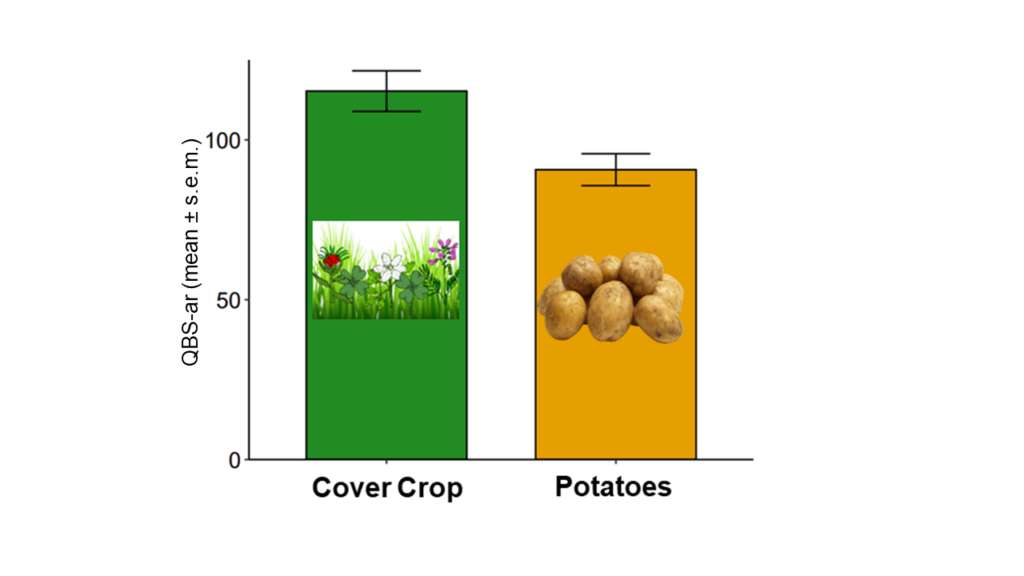
Wolf Farms
Three field-pairs were sampled at Wolf farms in 2021. For the purpose of this progress report, data shown here are averaged across all the field-pairs sampled at Wolf farms. Detailed data for each field-pair can be found in the 2021 Soil Arthropod Biology reports for Wolf farms (see Education and Outreach section). Soil arthropod Shannon diversity was greater in cover crop fields compared to spring crop fields (F1,50 =5.79, P=0.02) (Fig. 2a). Soil arthropod abundance was also significantly greater in cover crop fields compared to spring crop fields (F1,50 =8.17, P=0.006) (Fig. 2b).
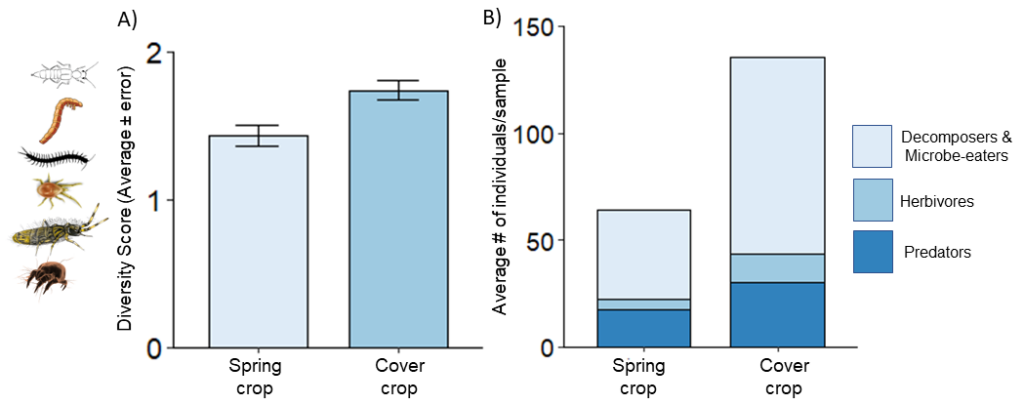
Reflecting our results for the Soil Stewards farm, QBS-ar was greater in soils under cover crops compared to all BAU spring crops (Fig. 3).
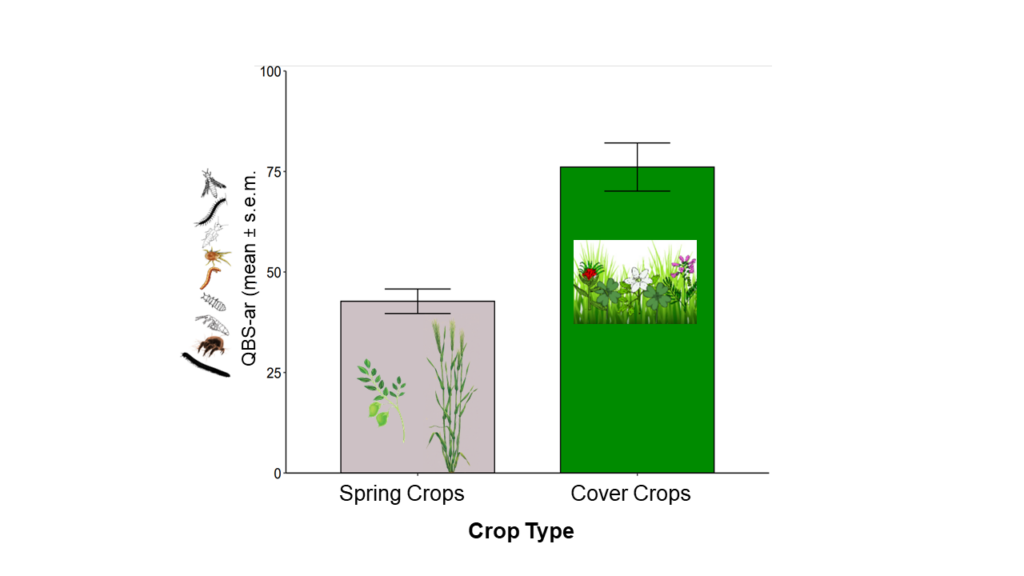
We took a multivariate analytical approach to compare the effects of cover crops and BAU crops on soil arthropod community composition. We applied non-metric multidimensional scaling to the combined community dataset from both producer farms sampled in 2021 (n=76 communities). We visualized the composition of soil arthropod communities by crop type (BAU vs cover crop) (Fig. 4). The extent of the overlapping ellipses in the ordination plot indicates community similarity. The lack of ellipse overlap between BAU crops and cover crops indicates that soil arthropod communities differ between crop types.
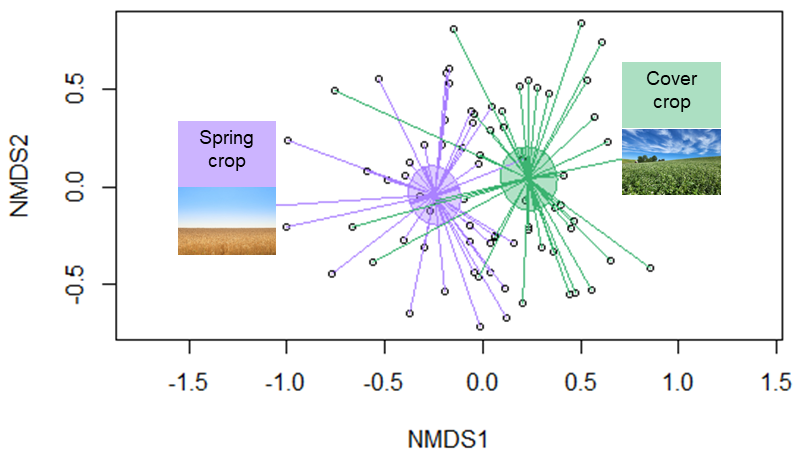
Small Plots (Obj. 2)
A total of 20,518 individuals from 51 different taxa were collected and identified from cover crop plots during 2019-2021. The most abundant groups collected were Acari and Collembola, with 12,657 individuals and 4,563 individuals, respectively. Psocodea, Thysanoptera, Hemiptera, and Coleoptera were the most abundant insect orders, with 1,286 individuals, 782 individuals, 463 individuals, and 198 individuals, respectively.
Results from the small-plot cover crop studies (2019-2021) indicate that cover crop species and level of diversity influence soil arthropod biodiversity and abundance. Arthropod abundance was highest in pea and polyculture treatments compared to fallow (Table 3). We observed that Shannon's diversity was higher in pea, clover, and polyculture treatments compared to fallow (Table 3). Taxa richness was greatest in polyculture cover crops compared to all other treatments (Table 3). We observed that QBS-ar was highest in the polyculture treatment compared to fallow or flax (Table 3). There were no differences in soil abiotic variables across treatments (Table 3).
Table 3. Mean soil abiotic variables and soil arthropod abundance, Shannon's diversity, taxa richness, and QBS-ar for cover crop species. Mean ± s.e.m. Means with rows assigned different letters are significantly different at P < 0.05. Polyculture treatment is a mix of all species.
| Crop | ||||||
| Fallow | Flax | Sunflower | Pea | Clover | Polyculture | |
| Abundance | 94.92 ± 28.20ab | 54.52 ± 8.46a | 115.63 ± 14.02ab | 163.70 ± 29.83b | 90.70 ± 16.48ab | 162.41 ± 29.89b |
| Shannon's Diversity | 0.80 ± 0.10a | 1.13 ± 0.11ab | 1.19 ± 0.13ab | 1.25 ± 0.12b | 1.29 ± 0.11b | 1.52 ± 0.12b |
| Taxa Richness | 4.54 ± 0.46a | 5.67 ± 0.62ab | 7.56 ± 0.72bc | 7.89 ± 0.76bc | 8.11 ± 0.77c | 11.37 ± 1.03d |
| QBS-ar | 32.69 ± 2.77ab | 27.70 ± 2.11a | 46.74 ± 4.17bc | 45.44 ± 4.26bc | 43.33 ± 3.95abc | 56.26 ± 4.59c |
| Soil pH | 5.22 ± 0.08 | 5.29 ± 0.06 | 5.28 ± 0.05 | 5.35 ± 0.04 | 5.36 ± 0.04 | 7.23 ± 1.86 |
| Soil VWC (%) | 5.42 ± 0.56 | 4.54 ± 0.45 | 5.24 ± 0.65 | 4.63 ± 0.56 | 4.35 ± 0.51 | 5.42 ± 0.65 |
| Soil Temp. (°F) | 76.91 ± 0.87 | 76.69 ± 0.91 | 77.14 ± 0.98 | 76.93 ± 0.86 | 76.65 ± 0.85 | 76.43 ± 0.89 |
Cover crop level of diversity differentially impacted the diversity of soil arthropod predator, decomposers & microbe-eaters, and herbivore functional groups (Fig. 5). The data showed a general trend of increasing diversity belowground with increasing cover crop diversity, but the effects on different functional groups varied slightly. For example, predatory soil arthropod diversity was not significantly increased by monoculture cover crops relative to fallow. A significant diversity increase was only observed in the polyculture treatment. In contrast, decomposers & microbe-eaters diversity was increased by monoculture crops relative to fallow. There was no difference in decomposers & microbe-eaters biodiversity between monoculture and polyculture cover crops. Analysis of 2022 winter wheat legacy effect data will assess if and how these cover crop driven changes in soil arthropod communities translate into changes in communities under winter wheat.
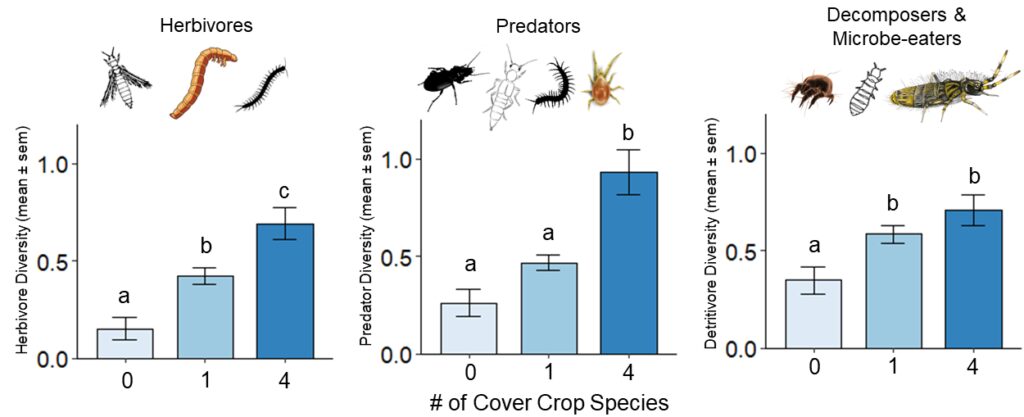
Contrasts between monoculture cover crops and fallow and polyculture cover crops and fallow comparing QBS-ar revealed that polyculture crops significantly increased the soil's QBS-ar score compared to fallow, whereas we observed no significant difference in QBS-ar between monoculture cover crops and fallow (Fig. 6). Analysis of 2022 legacy effect data will assess if cover crop driven changes in QBS-ar translate into changes in wheat biomass and QBS-ar in soils under winter wheat.
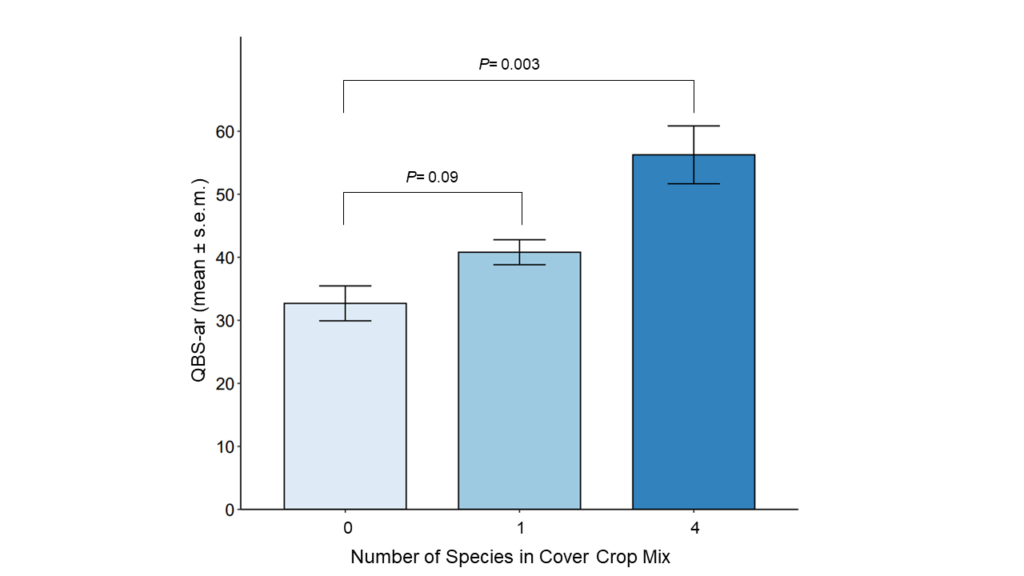
Litterbags (Obj. 3)
Previous cover crop treatment and mesh size had significant effects on the rate of litter decay (k) in winter wheat plots. Litter decay rate was significantly reduced when soil arthropods were excluded from litterbags (F1,93 =7.81, P<0.001). When soil arthropods could access litterbags, the litter decay rate in winter wheat following the polyculture cover crop treatment was greater than the litter decay rates in winter wheat following the other cover crop treatments tested (F1,93 =3.47, P=0.006) (Fig. 7).
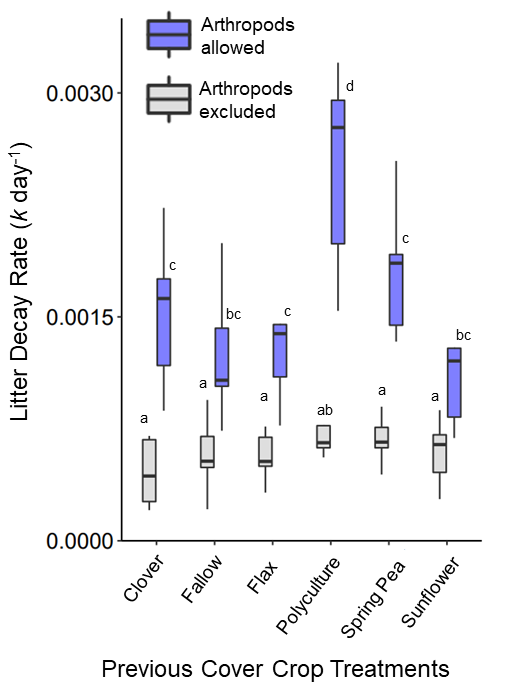
Using the k values calculated from the litterbag experiment data, we modeled litter decomposition dynamics in winter wheat under each legacy cover crop treatment scenario for both litterbag mesh sizes using the standard negative exponential model (Mt=M0e-kt) to visualize and compare litter decomposition trajectories over time (1095 days). Previous cover crop treatment alters litter decomposition trajectories in winter wheat (Fig. 8). Soil arthropods accelerate litter decomposition in winter wheat, especially following polyculture cover crops.
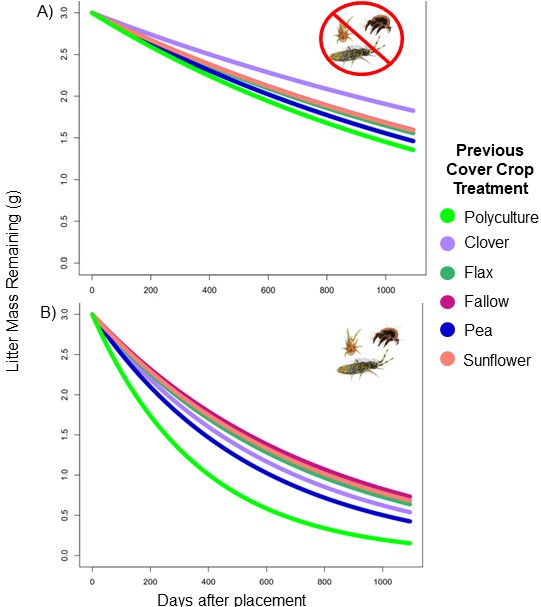
Soil arthropod community abundance and diversity in previous cover crop treatments (2021 data) were positively related to litter decay rates in the following winter wheat crop (Fig. 9).
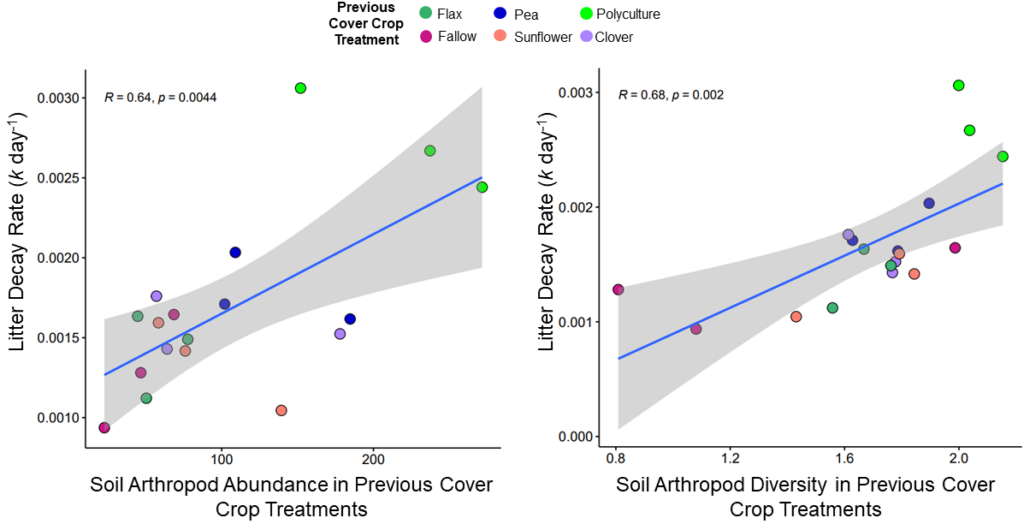
Discussion
The responses of soil arthropod communities to cover cropping have never been documented in the IPNW prior to this project. Preliminary results from this project indicate that cover crop type and diversity influence soil arthropod communities. Cover crop mediated-changes in soil arthropod communities affected the delivery of soil-based ecosystem services (i.e., litter decomposition) in the following winter wheat cash crop. Planting cover crops promotes the abundance and biodiversity of functional groups that support sustainable agriculture.
The overarching question "Is there potential for producers to manage their soil biology with cover crops?" guided our first two objectives. Initial results from the on-farm (Obj. 1) and small-plot (Obj. 2) studies indicate that cover crops are one potential avenue for producers to manage soil arthropod communities and their associated ecosystem services. Soil organisms, including arthropods, are known to be negatively affected by industrial agricultural practices that include intensive monoculture cropping (i.e., spring crops planted during on-farm studies) and fallow (i.e., fallow treatment used in small-plot study). Our results agree with this notion. When farmer's planted cover crops instead of spring crops, there was an increase in soil biodiversity. This supports our Obj. 1 hypothesis that soil arthropod biodiversity is greater under cover crops compared to the spring crops farmers could have planted, but did not. Furthermore, the overall community composition of arthropod communities was different between spring crop and cover crop fields. Like changes in biodiversity, changes in community composition can affect the delivery of ecosystem services. This provides further evidence that there is potential for producers to manage and promote belowground arthropod communities through cover cropping.
In concordance with the on-farm studies, we observed that cover crops promoted soil arthropod communities in the small-plot study. Legume monoculture cover crops, like clover and spring pea, and a four species cover crop mix, increased soil arthropod biodiversity and abundance relative to fallow. Changes in soil arthropod abundance and diversity in response to flax and sunflower were not consistently different from the fallow treatment, suggesting that monoculture crops affect soil arthropod communities differently. Similarly, we observed that different levels of cover crop diversity favor different functional groups of soil arthropods. Results from this study support our Obj. 2 hypothesis that cover crop diversity aboveground promotes soil arthropod diversity belowground. Indeed, polyculture cover crops were most effective at increasing the diversity of predatory soil arthropods. The extensive root systems of the polyculture treatment may have increased habitat complexity in the soil that favored predatory soil arthropods. Understanding the differences in functional group responses to different levels of cover crop diversity allows for a more targeted soil ecological engineering approach for improving ecosystem functioning and services. Soil biodiversity loss and community simplification impairs soil processes, like decomposition, nutrient retention and cycling, biocontrol, and primary productivity. Therefore, management practices like cover cropping that promote soil arthropod biodiversity could lead to changes in ecosystem functioning leading to subsequent benefits for soil health and crop yields.
In contrast to soil arthropod responses, we observed no changes in soil abiotic variables between cover crop treatments during our small-plot study. Notably, there were no detectable changes in soil water content relative to fallow. This effect can depend upon when cover crops are terminated. Cover crop treatments in our small-plot experiment were terminated by mowing in the last week of July (2019-2020) and the third week of August (2021). We observed a similar result for our on-farm study. Soil moisture was not depleted by cover crops (average 7.35% VWC) and was approximately the same as spring planted crops (7.87% VWC) when average across the growing season (see 2021 Soil Arthropod Biology Report: Wolf Farms for data). Concerns over soil moisture retention have been a major limitation to cover crop adoption in dryland farming regions. Results from our small-plot study suggest that fallow provides no water retention benefits compared to the cover crop treatments used in our study. No statistically detectable changes to soil water content relative to fallow or spring crops, along with augmented soil arthropod biodiversity and abundance, have the potential to make cover crops, especially multi-species mixes, a great tool to improve soil health, manage belowground organisms, and promote sustainability in IPNW agroecosystems.
The third objective of this study focused on measuring the contribution of soil arthropod communities to litter decomposition in winter wheat following different cover crop treatments. Litter breakdown is regulated by litter quality and soil biotic and abiotic conditions. Soil arthropods have a substantial influence on litter decomposition through physical litter breakdown and grazing on microorganisms that are the ultimate biogeochemical cyclers. However, soil arthropod contributions to litter breakdown can be influenced by many factors, including agricultural management decisions. Given the strong feedbacks between soil arthropod communities and litter decomposition dynamics, the effects of management decisions like cover cropping could affect litter decomposition via influences on the soil arthropod community. In the present study, cover crop effects on soil arthropod communities affected litter decomposition in the subsequent wheat crop. Consistent with arthropods known effect on litter comminution, arthropods increased the litter decay rate in winter wheat following all cover crop treatments except sunflower and fallow. The litter decay rate in sunflower and fallow did not statistically differ from the litter decay rate in litterbags where arthropods were excluded following the polyculture cover crop treatment. Litter decay rate was highest in winter wheat following polyculture cover crops when arthropods were allowed to access the litter. Indeed, litter decomposition trajectories vary greatly based on whether soil arthropods are allowed or excluded. For example, over 50% of litter remains when arthropods are excluded from litterbags regardless of the previous cover crop treatment. The litter decay rate (k) can be considered an ecosystem productivity indicator, suggesting that ecosystem functioning is promoted in winter wheat when arthropods are able to access litter, especially following polyculture cover crops.
Cover crop species and diversity affects soil arthropod communities, as we have shown in this study (Obj. 2). Overall, higher soil arthropod abundance and diversity in previous cover crop treatments (2021) were positively correlated with higher rates of litter decay in winter wheat (2022). Indeed, litterbags recovered from winter wheat plots following spring pea and polyculture cover crops had the greatest abundance of arthropods (preliminary data not shown). This suggests that increased abundance of soil arthropods in 2021 cover crops translated into increased abundance in litterbags in the following 2022 winter wheat crop thus accelerating decomposition. It follows that litterbag decomposition trajectories varied based on previous cover crop treatment. The most rapid litter decay trajectory was detected in winter wheat plots that were previously planted with the polyculture cover crop treatment that was the best at promoting soil arthropod abundance and diversity. These results indicate that the type of cover crop planted prior to seeding winter wheat can modulate the arthropod-mediated decomposition of plant litter. Litter breakdown can be especially important for IPNW producers using reduced-till systems that leave plant debris on the soil surface. Management of soil arthropod communities using multi-species cover crop mixes has the potential to improve soil-based ecosystem services like litter breakdown in agricultural soils.
The fourth objective of this study was to evaluate soil health using arthropods as bioindicators. The Soil Biological Quality index (QBS-ar) is an index that was developed to assess soil quality by using arthropods as biological indicators. The QBS-ar weights soil arthropod taxa based on their adaptation to the soil habitat, assuming that the number of arthropod groups morphologically adapted to the soil is higher in healthier soils. This index combines soil arthropod community biodiversity and the arthropod's level of adaptation to the soil environment. QBS-ar values were calculated for every community we collected during the on-farm and small-plot studies. Results from our small-plot studies suggest monoculture cover crops do not improve soil quality compared to fallow, as measured using QBS-ar. In contrast, the polyculture cover crop improves soil quality relative to fallow and monocultures. Growing a polyculture cover crop seems to maximally promote soil arthropod biodiversity and soil quality relative to the monoculture crops we evaluated. Information on how monoculture cover crops affect soil arthropod biodiversity, function, and soil health (as measured by QBS-ar) relative to polyculture cover crops will move us closer to producers being able to ecologically engineer their agroecosystems to support desired ecosystem services.
Results from the on-farm studies were consistent with our small-plot experimental work. Cover crops grown by our producer collaborators affected the composition of the soil arthropod communities and the QBS-ar values of their soils. Soil quality, as measured by QBS-ar, was greater in cover crop fields compared to BAU non-cover crop fields. This increase in soil quality, measured using arthropods as bioindicators, suggests that cover crops are improving soil health in our producer-cooperator fields. The creators of the QBS-ar index report that a mean QBS-ar of 93.7 "can be considered a tentative threshold that separates high quality soils and values which are typical for poor soils". Soils sampled from the cover crop field at the Soil Stewards farm surpassed this threshold, but soils sampled from cover crop fields at Wolf farms remained below this threshold value. Whether this difference in cover crop effect on QBS-ar between organic and conventional farms is a consistent pattern deserves further attention. The rapid and measurable change in QBS-ar suggests this index may be a useful tool for monitoring soil quality after changes in managements practices. In the past, evaluating soil health in response to management practices has focused on chemical (e.g., pH) and physical (e.g., volumetric water content) parameters. But by solely measuring these physiochemical parameters, which may not always respond quickly to management changes, we may be overlooking biological indicators that can provide important clues as to how management practices influence soil health.
Compared to conventional dryland farming practices, like fallow or planting spring crops, cover crops increased soil arthropod biodiversity, potentially improving the delivery of ecosystem services in agroecosystems. Indeed, based on the results of this study, including polyculture cover crops in rotation with a cereal cash crop can be used to promote belowground arthropod biodiversity and, in turn, improve the arthropod-mediated decomposition and nutrient cycling of plant litter in agricultural soils. Cover crops that augment desirable functional groups, like predators and decomposers & microbe-eaters, can potentially be used to ecologically engineer agroecosystems to benefit producers. Results from our on-farm and small-plot studies so far indicate that cover crops, in addition to agronomic benefits they may provide, can simultaneously promote diversity in beneficial soil arthropod communities and improve soil health, as measured by QBS-ar.
To maximize benefits from agroecosystem soils redesigning agricultural production systems will be necessary. This project has integrated knowledge on how arthropod diversity and functioning in soils respond to agricultural management decisions. Producers using cover crops as management tools for targeted soil ecological engineering is a valid approach for conserving and promoting soil arthropod biodiversity and ecosystem services, like litter decomposition, that are necessary for the development of sustainable cereal-based agroecosystems in the IPNW.
Research Outcomes
This collaborative project used replicated field experiments and on-farm research trials to investigate how cover crop use and cover crop diversity impacted soil arthropod biodiversity and functioning compared to crops that cover crops could replace in rotations. After data analysis is complete, this research will be published in a peer-reviewed journal. Results will also be shared in an Extension Bulletin coming in early 2023. Outcomes from this project will support adoption of cover cropping in Inland Pacific Northwest (IPNW) dryland cereal-based cropping systems.
For soil ecosystems to function, soil biodiversity must be conserved and promoted. Soil arthropods have the potential to enhance sustainable ecosystem functioning. Results from Obj.1 of this project indicate that cover crops currently being used by early-adopter producers in the IPNW boost belowground arthropod biodiversity relative to the spring crops they could replace in rotation. This suggests that cover cropping on large-scale, commercial farms can be a valuable strategy to conserve and promote soil arthropod communities and their functioning. All the cover crops utilized on working farms in Obj. 1 were multi-species mixes. Our results from Obj. 2 highlight that multi-species cover crops are better than single species cover crops for conserving and promoting soil arthropod biodiversity. Furthermore, we detected legacy effects from multi-species cover crops on soil arthropod-mediated litter decomposition rates in subsequent cash crops (Obj. 3). Results from our project suggest that the increased soil arthropod biodiversity in multi-species cover crops is positively related to the rate of litter decomposition in subsequent winter wheat cash crops.
Together, results from this project suggest that multi-species cover crops can be used to manipulate soil arthropod communities to maximize their contributions to soil processes, like litter breakdown, to support the development of more sustainable agricultural systems. Based on the results from this project, we would recommend that farmers seeking to conserve and promote soil arthropod communities and their associated functions should plant multi-species cover crops instead of single species cover crops when they are able. Cover crops can be used to optimize the internally mediated processes performed by soil arthropods to maximize the delivery of ecosystem services, like decomposition and nutrient cycling, and ideally reduce off-farm inputs in dryland cereal-based agroecosystems in the IPNW
Adoption of cover cropping has lagged in our study region, partially due to a lack of research on cover crops in the IPNW, specifically. Outcomes from this project contribute to a growing repository of cover crop information in the region. This project informed the ongoing project "Pacific Northwest Cover Crop Decision Aid System" funded by Western SARE (SW22-940). These projects, amongst others, are positioning the University of Idaho as a regional hub for cover crop research and information dissemination for dryland cereal producers in the IPNW.
Our project's outcomes and our ongoing interactions with producers suggest several areas for future study. While producers were receptive to hearing about cover cropping and agricultural diversification strategies that can be used to promote soil arthropods, they had several questions pertaining to more specific conventional management practices and their impacts on soil organisms. For example, researchers were interested in region-specific information about how fertilizer applications, foliar insecticides/miticides, and anhydrous ammonia applications affect soil arthropods. Producers were also interested in the "bounce-back" time of these communities after potentially negative management practices that may be unavoidable in some operations. This type of information does not exist for the IPNW, and these questions could lead to rich research directions that are driven by the interests of producer-cooperators and stakeholders.
Future research should also focus on deciphering the mechanisms behind why multi-species cover crop mixtures are better at promoting soil arthropod biodiversity relative to single species cover crops. Understanding these mechanisms can lead to the optimization of cover crop mixes to support soil biodiversity, with the potential to create mixes that can be used to ecologically engineer agroecosystem soils to support beneficial arthropods and preferred ecosystem services. Finally, it will be vital to know to what extent ecosystem services provided by soil arthropods, which we have shown can be promoted using cover crops, can compensate for anthropogenic inputs.
This study was the first in the IPNW to examine rigorously how cover crop diversity impacts the biodiversity of belowground arthropod communities and their contributions to soil processes. This project has improved our understanding of the interplay between agricultural management practices, the diversity and composition of soil arthropod communities, and their functioning in agricultural systems. We would recommend multi-species cover crops as a management strategy that provides numerous agricultural benefits while simultaneously conserving and promoting beneficial soil arthropods. Conservation and promotion of soil biodiversity is vital for improving soil health and the long-term sustainability of dryland cereal-based agriculture. Management strategies that promote soil arthropod communities and their ecosystem services will be of pivotal importance in order to create productive and sustainable agroecosystems.
Education and Outreach
Participation Summary:
We have participated in several outreach activities centered around agricultural diversification in 2021 and 2022. Information on cover crops, soil arthropods, and preliminary project results were shared with producers and professionals at the Genesee Area Crop Tour in Latah Co., ID (2021 (26 participants) & 2022 (12 participants)) the Bonners Ferry Field Day in Boundary Co., ID (2021 (23 participants)), the Northern Idaho Collaborative Field Day in Nez Pearce Co., ID (2022 (approx.40-50 participants)), the Prairie Area Crop and Conservation Tour, Lewis Co., ID (2022 (approx. 25-30 participants)), the Farmington Field Day in Whitman Co., WA (2022 (10 participants)), and the Soil Stewards Farm Day in Latah Co., ID (2022 (5 participants)). Factsheets that included project results and take-home messages complemented the field day presentations and were distributed to all attendees. (Field Day Handouts 2022, Field Day Handout 2021) The exact number of agricultural stakeholders who participated in educational activities listed (16) represents only the participants that we could confirm. There were likely several more of these stakeholders in attendance at the field days.
Additionally, preliminary results were reported in the 2022 Dryland Field Day Abstract book (pg. 57) that is published jointly by Washington State University, Oregon State University, and the University of Idaho. Field day abstracts are available for free download from extension sites across these three universities enhancing our outreach capabilities across the Inland Pacific Northwest.
Producer-collaborators Frank Wolf and Alison Detjens (Soil Stewards Farm) were provided with reports (hard copies and electronic) that summarized the 2021 preliminary results from on-farm sampling. Additionally, attendees of the Soil Stewards Farm Day all received the 2021 Soil Stewards Soil Arthropod Biology report. Producer-collaborator Jensen was also provided with these reports from his colleague's farms. Jensen will receive a similar report summarizing 2022 sampling efforts. These reports also include information on abiotic soil factors that were collected at the time of arthropod sampling, like pH, soil temperature, and soil volumetric water content.
Project objectives and preliminary results were presented and discussed during the 2021 University of Idaho Entomology, Plant Pathology and Nematology departmental seminar series in a talk titled, “The ecology of soil arthropods in agroecosystems: Effects of agricultural diversification on community structure, function, and interactions”. Additionally, Elmquist delivered an oral presentation reporting and discussing project results titled, "Effects of cover crops on the structure and function of soil arthropod communities" at the 2021 Entomological Society of America national meeting (Oct 31-Nov 4 Denver, CO). Project results were also presented in a poster at the 2022 Institute for Health in the Human Ecosystem Annual Research Symposium on April 7, 2022 at the University of Idaho in Moscow, ID. Data from this project was included in an invited oral presentation at the 2022 Entomological Society of America meeting (Oct 13-16 Vancouver, B.C., Canada) titled "Designing agroecosystems to promote soil arthropods" delivered by Elmquist.
Elmquist was a guest on the Wheat Beat Podcast with Dr. Drew Lyon where they discussed the effects of agricultural diversification practices on soil arthropod communities. The podcast was released on the Washington State University Wheat and Small grains website. While cover crops and the Western SARE work were not the main subject of discussion, a link to this project on the SARE website was provided for listeners to access more information about cover crops and soil arthropods. The podcast is available on iTunes, Stitcher, SoundCloud, ApplePodcasts, and Spotify.
Results from this project were shared during two 1.5 hr-long courses titled "Macrofauna & Soil Health: Getting to know our belowground partners in PNW wheat systems" at the 2022 Washington State University Wheat Academy. Each session included a breakout period where attendees interacted with and observed live soil arthropod communities, engaged with researchers, and asked questions. There was a total of 30 attendees (57 total registered for the academy). We advertised our University of Idaho Extension Bulletin (described below) and received interest from several growers. Growers described the need for more regionally specific information on arthropods in agricultural systems. Our bulletin will serve those needs. However, we were encouraged by the fact that several farmers had previously heard about some of the organisms we were discussing. This is a change from previous years where these organisms were unknown to most audiences.
As we outlined in the July progress report, in our initial proposal we planned to produce a guide booklet that outlined the QBS-ar index protocol, accompanied by pictures of soil arthropods commonly encountered in the IPNW. We planned to test the utility of this index with producers at various outreach events, like the 2021 Washington State University wheat academy, that ended up being canceled due to COVID-19 in 2021. We saw this as an opportunity to re-think our strategy on publishing educational materials and opted to create a University of Idaho Extension Bulletin focused on introducing farmers to soil arthropods titled "Soil Insects and other Arthropods in Palouse Agroecosystems". The University of Idaho Extension/Idaho Agricultural Experiment Station accepted the bulletin for publication on 12/9/2022. To our knowledge there are no similar sources of information about soil arthropods in the Pacific Northwest. The USDA-NRCS has a general information page on soil arthropods, but our bulletin is regionally based and includes outcomes from this project.
Once published, the bulletin will be posted online at the University of Idaho extension website where it is free to access and download. Additionally, we will print high-quality hard-copy bulletins to send to extension centers in Northern Idaho to include in their educational material offerings. Furthermore, the bulletin will be shared with Western SARE and will be available for download as an information product. Additionally, posting the bulletin on the SARE website as a product would enhance its reach. The bulletin will be added as a product in the Information Products section when it is published.
Our education and outreach activities at various venues reached a wide variety of producers and members of the scientific community. Despite the significant role arthropods play in the soil ecosystem, they are not typically well known to farmers, especially compared to earthworms and soil microbes. Our outreach efforts aimed to introduce producers to these often-forgotten organisms and provide avenues to manage these communities in agricultural soils. These efforts have culminated in an Information Product and University of Idaho Extension Bulletin titled ""Soil Insects and other Arthropods in Palouse Agroecosystems". This bulletin will be freely available online in early 2023. The purpose of this bulletin is to introduce farmers and members of the agricultural community to the insects and other arthropods that live in agricultural soils in the Palouse region of the Inland Pacific Northwest. We include information on management practices to promote soil arthropods using data generated from our on-farm research supported by this Western SARE project.
If producers are not familiar with soil arthropods, it makes it more difficult to convey results in sessions like fields days or on-farm demonstrations when the use of graphics and videos is limited. The base-line knowledge producers have about arthropods is incomplete compared to the baseline knowledge they possess about soil microorganisms and earthworms. As researchers, we must improve our efforts to educate producers about these communities so that information presented at field-days or in non-traditional settings is more interesting and engaging. It is imperative that producer's concept of "soil organisms" include more than just earthworms and microbes. Our extension bulletin will aid in these familiarization efforts and should improve future field day presentations focused on soil arthropods.
Field day handouts and periodic soil biology reports to our farmer collaborators were effective methods to keep producers up to date on our project findings each year. Publishing results in the Dryland Field Day Abstract book, which reaches producers in Washington, Idaho, and Oregon was an effective way to maximize our reach and impact. While there is no way to truly know, these efforts may have introduced more producers to soil arthropods within the life of the project. During 2021 outreach events, producers were asked if they had ever heard of some common soil arthropods (e.g., springtails). No hands went up. At 2022 outreach events, a few producers indicated that they were familiar with some common soil arthropods. Publishing preliminary results in extension publications was an effective way to communicate project results prior to the completion of the project and will be valuable in continuing to familiarize producers with these important soil organisms.
Participants at education and outreach events were given the opportunity to evaluate the events with a survey. Overall survey results are displayed in Table 4. Overall, our outreach efforts to improve awareness about soil arthropods in agricultural systems and how cover crops impact their communities appear successful. All participants that returned surveys indicated that their awareness of soil arthropods in agricultural systems improved. Despite this, not all participants modified their attitudes. This suggests that outreach efforts need to focus on improving the connection between soil arthropods and their impacts on cash crop yield, soil health, and other agronomic aspects. This notion is also reflected in the fact that not all farmers surveyed plan to adopt the cover cropping practices we discussed or increase their operation's diversification. Nonetheless, our education and outreach results did modify the opinions and attitudes of nearly 80% of respondents. Introducing producers and the agricultural community to the connections between soil arthropods, soil health, and management practices was a primary goal of our outreach efforts. Knowledge shared from our project will contribute to a holistic understanding of cover crops in dryland agroecosystems that could support increased adoption of cover cropping in the future.
Table 4. Results of education and outreach survey. A total of 23 participants (approx. 13% of total audience) returned their surveys. The number of questions answered by each survey participant varied.
| General Knowledge | Percent responding "yes" |
| Improved awareness of topics covered | 100 |
| Provided new knowledge | 100 |
| Provided new skills | 73 |
| Modified my opinions/attitudes | 78 |
| In the next year I am likely to use some aspect of this project to: | |
| Adopt one or more of the practices shown | 73 |
| Increase the operations diversification | 67 |
| Reduce my use of purchased off-farm inputs | 42 |
| Increase my networking with other producers | 58 |
| Incorporate value-added into some aspects of my operation | 75 |
In addition to quantitative survey results, several farmers qualitatively rated our outreach programs. One producer wrote "Fantastic!" describing the information presented at the 2021 Genesee Area Crop Tour. Another wrote "Good literature provided" in reference to our field day handouts. One producer commented that handouts included a "good combination of graphs/figures and written documentation". This is evidence that our field day handouts were an effective way of reporting preliminary project results to producers and stakeholders while the project was underway. Surveyed participants indicated they would share the information they learned with over 100 people.
Overall, producers and stakeholders seem to agree that soil arthropods should be considered in the soil health framework. Several producers were interested in how biological organisms could be used to measure soil health. This suggests that our research focusing on using QBS-ar to measure soil health (Objective 4) is relevant to producers. This could be a rich area of future research that would be supported by producers and stakeholders.